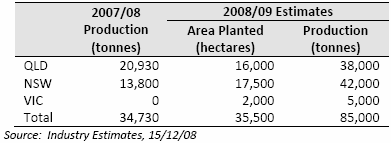Australia
December, 2008
Source:
Australian Oilseeds
Federation (AOF)
 Canola 2008/09 Canola 2008/09
While there was a disappointing end to the east coast
season, the west has held up production and overall estimates
are pretty much unchanged from last month. The rains finally
came, but much too late for most of the 2008 canola crop.
Harvest is well and truly underway in NSW and has commenced in
all other states. Harvesting has been hampered by above average
rainfall in all states, but there have been few reports of
damage due to the rain. Most of the crop damage occurred in late
October and November as a result of the widespread frosts across
NSW, Vic and South Australia.
Most of the NSW canola crop has now been harvested. Crops in the
western part of the southern and central regions have recorded
oil contents in the low 30's, with some being rejected as below
30%. On average oil contents have ranged between 35‐40% in the
main canola growing areas, and up to 43% has been reported.
Yields in the north have been above average and some yields on
the eastern side of the central region have
been better than expected. Quality has been variable in terms of
seed sizes and appearance. Yields have also been variable with
some dryland crops achieving yields of up to 2.3 t/ha, but
generally have been below expectations.
Rain has hampered harvest activities in most of Victoria.
Harvest is complete in the North East, with a wide range (0.3‐
1.3 t/ha) in yields from frost affected crops. Oil content has
also been affected, averaging 34‐35%. A proportion of the crop
was cut for silage. In the Western District harvest is still
being delayed by rain and a large area of crop is still to be
harvested. Frost is expected to see variable oil contents and
yields.
As for much of the year, South Australia is a similar scenario
to Victoria. The heavy rainfall in late November continuing into
December, has delayed harvest. However, frost damage in November
may not have been as severe as first reported. Harvest is
expected to be fully underway by late December.
Harvest across Western Australia has been held up by the
continuing wet weather. While frustrating for growers, this has
not resulted in any grain quality issues as yet and yields look
to be average or better in most areas not affected by frost.
There has been some downside reported in crop affected by the
early September frost, and the damage to yield has been
estimated at between 10 and 90% in affected crops. Overall the
forecast has been slightly increased to almost 900,000 tonnes.
 Sunflower
2008/09 Sunflower
2008/09
The early crop plant is very similar to last year. There was
potential for a reasonable late plant, however, lower prices are
expected to impact predictions. Thus, estimates have been
revised down slightly from the previous month.
Early sunflowers in northern NSW are ranging from flowering
through to petal drop. The recent rainfall across northern NSW
has been beneficial to the early crop. There has been very
little pressure from Rutherglen bug, but reports of heliothis
has been building. Late planting has not commenced as yet, but
with a brighter moisture outlook, there is some degree of
interest. On the Liverpool Plains, rain throughout November has
also benefited early sunflower plantings, although some areas
have reported water logging. Crops are ranging from late
vegetative stage through to budding. Insect pressure has been
minimal. The early crop on the Darling Downs has commenced
flowering and is reported to be in good condition and benefiting
from rainfall.
 Soybean
2008/09 Soybean
2008/09
While rainfall and current market indications has hampered
plantings somewhat, the soybean crop is forecast to increase
significantly on last year's crop. |
|